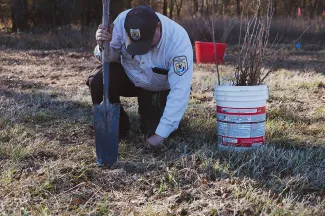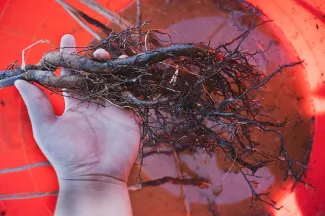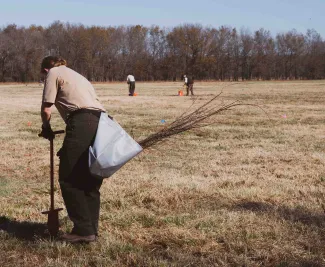Trees can be an essential source of habitat for our wildlife communities, making tree planting – in areas where trees naturally occur – a great conservation pursuit! But not all planted seedlings will survive to provide wildlife with food or cover. To get tips that may increase seedling survival and their value to wildlife, we checked in at an ongoing restoration site at Deep Fork National Wildlife Refuge in central Oklahoma.
Work for Good Root-to-Soil Contact

Seedlings should be planted so that the root collar is slightly below ground line. If trees are planted in loose soil or without good root-to-soil contact, the seedlings could settle in the coming weeks causing the roots to sink below the optimal depth.
If planting a small number of trees, U.S. Fish and Wildlife Service biologist Doug Schoeling recommends using a sharp shooter shovel. "But if you'll be tackling a bigger project where thousands of trees will be planted, you might consider investing in a dibble bar." The specialized dibble bar blade creates a vertical opening in the soil, allowing the seedling to stand straight up when planted. Whether you use a sharp shooter shovel or dibble bar, drive the tool in the ground and then pull it forward to create a hole in the soil behind the shovel or bar. Place the tree in the newly created hole, pull the shovel or bar from the soil and step on the soil in front of the tree to firmly plant the tree in the soil.
Plant Seedlings with the Roots in the Right Direction

"Roots will continue to grow in the direction they're planted, so make sure the roots stay down," Schoeling said.
If the seedling is placed at the very bottom of the hole, the roots may bend and form a "j." "Roots of a 'j-rooted' seedling could gradually grow aboveground, which would eventually kill the tree."
Plant Many Different Species

"Diversity is key if the end goal of your tree planting effort is to benefit wildlife," Schoeling said.
Planting a variety of tree species, like native oaks, plums, hackberry, or hickories, will provide a variety of wildlife food and wildlife cover as the seedlings mature.
Give the Seedlings Plenty of Space

Research the space requirements of the tree species you will be planting. On average, smaller species like redbuds can be planted closer together than larger species like oaks or pecans. "We're planting seedlings about 12 feet apart of this restoration project," Schoeling said.